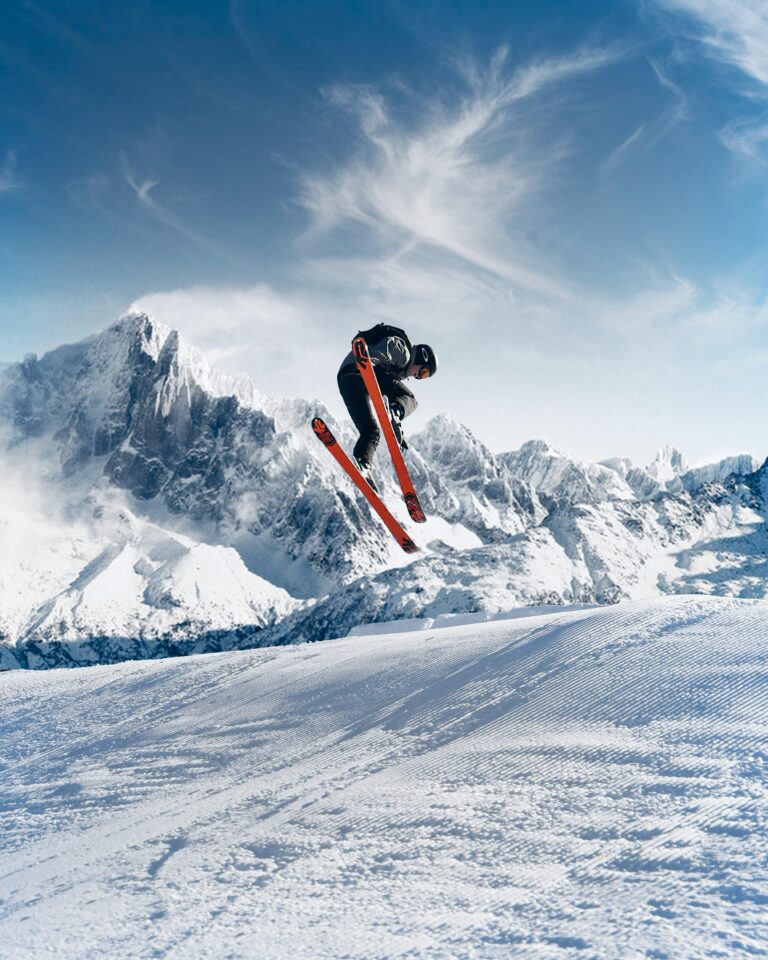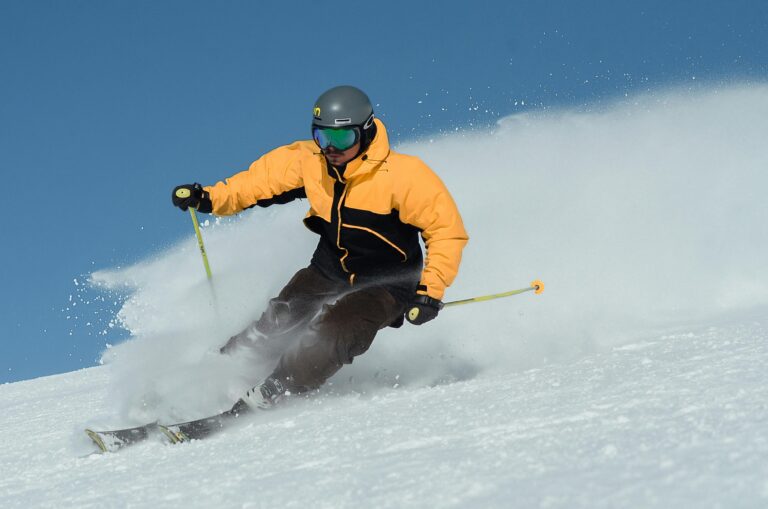In general, skiing can lead to knee pain or injuries if proper techniques and precautions are not taken. Factors such as the mechanics of skiing, the type of terrain, and individual skiing style influence knee stress, making awareness of risks essential for both enthusiasts and beginners.
Skiing is an amazing way to escape into the snow-covered outdoors, but I’ll be honest—those knees of yours are working overtime. Every twist, turn, and jump puts a surprising amount of pressure on them.
If you’re new, it’s easy to get caught up in the thrill and then suddenly find yourself face-first in the snow after a sharp turn. For those of us who have skied for years, it’s often those nagging aches or past injuries that remind us to be careful.
And if you’re dealing with old knee issues? Hitting the slopes can feel a bit like a gamble. So before you strap in, it’s worth getting familiar with how skiing can affect your knees and what you can do to protect them.
How Do Skiing Techniques Affect Your Knees?

Common skiing postures and movements play a major role in knee health. Key techniques that exert stress on the knees include improper weight distribution and abrupt turns, with different styles, like parallel versus snowplow, having varying impacts on strain.
How you move on the slopes makes all the difference. Think of it like balancing on slippery ice—one wrong shift, and you’re on your backside.
Here’s what I’ve noticed:
- Leaning too far forward while crouching turns your knees into the muscles’ punching bags rather than letting them flex naturally.
- Putting too much weight on one ski messes with the balance and stresses one knee more than the other. That’s a quick way to invite injury.
Different skiing styles add their own challenges. Parallel skiing gives you speed and agility but pops more lateral stress on your knees. The snowplow is a solid beginner’s friend, bringing control, but if you push it too hard, it can lead to bad habits.
Just being aware of how your moves impact your knees can keep you skiing longer and with less pain.
What Are the Most Common Skiing Injuries to the Knee?
Common knee injuries from skiing include ACL tears, meniscus damage, and ligament strains. According to the CDC, skiing presents a 25-35% injury risk every season, with knee injuries making up a substantial portion of that statistic.
Skiing delivers a rush, but your knees can pay the price. Here’s a quick rundown of common injuries you should watch for:
- ACL Tears: This ligament is like the knee’s shock absorber. Sudden stops or sharp turns can snap it, turning your run memorable for all the wrong reasons.
- Meniscus Damage: Twist your knee wrong, and that cushioning cartilage can tear. Expect swelling and a sharp jab of pain.
- Patellar Tendonitis: Ever heard of “jumper’s knee”? It sneaks up after constant pounding—your knee’s way of asking for a break.
Statistics:
- The CDC reports about 600,000 skiers wind up in ERs yearly due to skiing injuries. A big chunk involves knees.
Knowing these risks helps you spot danger before it ruins your season.
What Preventive Measures Can Skiers Take to Avoid Knee Pain?
To avoid knee injuries, skiers should consider warm-up routines, engage in strength-training exercises, and select proper gear. Stretching before hitting the slopes is crucial to prevent injuries.
I can’t stress this enough: warming up and strength work pay off big time. Here’s how to keep your knees happy on the snow:
- Stretch those quads, hamstrings, and calves for at least 10-15 minutes before skiing.
- Build leg muscles with squats, lunges, and leg lifts. No gym? No problem—you can do these at home.
- Invest in boots that fit your feet like a glove. Loose boots mean wobbly knees and less control.
- Take regular breaks. It’s tempting to push through, but your knees need rest to avoid overload.
Customizing these steps to fit your body and style will save you from a lot of knee pain later.
How Is Proper Ski Equipment Essential for Knee Health?
The choice of ski equipment significantly affects knee health. Properly leveraged equipment, like knee braces or gear specifically designed for women, can support the knees and reduce injury risks.
Gear isn’t just about looking cool; it plays a big role in how your knees hold up.
- Knee braces can feel like seat belts for your joints if you’ve had injuries before. They stabilize and protect when it counts.
- Boots should be snug but not pinching. Poorly fitted boots throw off your alignment, stressing your knees.
- Ladies, take note: equipment tailored for women isn’t just marketing. It matches anatomical differences and supports your knees better.
One friend who switched to custom braces told me her knee pain nearly disappeared. That’s the kind of relief that lets you enjoy your runs again.
What Are Effective Exercises for Knee Strengthening?
Essential exercises for knee strengthening include squats, lunges, and step-ups. Experts endorse these workouts for enhancing muscle support around the knee joint and improving overall stability during skiing.
Getting your knees stronger doesn’t have to be a grind. Here’s my go-to list:
- Squats – 3 sets of 10-15 reps. Pretend you’re sitting in a chair, keep your back straight.
- Lunges – Forward and backward lunges build balance and strength around the knees.
- Leg presses – Great for targeting your quads.
- Single-leg balance – Stand on one leg to improve stability and core engagement, crucial for managing turns.
If videos help you get form right, check out Best Exercises for Skiing — it really breaks it down.
What Recovery Practices Should Skiers Consider for Knee Health?
Recovery techniques such as rest, ice, compression, and elevation (RICE) are vital after skiing. Engaging in physical therapy can benefit knee health and alleviate discomfort.
After skiing, don’t ignore your knees—they need some TLC.
- Rest as much as your body tells you to.
- Ice your knees for 15-20 minutes to ease swelling.
- Wrap and elevate to keep inflammation down.
- If you’re dealing with ongoing pain, physical therapy is your friend. They’ll help rebuild strength and flexibility safely.
Skip recovery, and you’ll pay for it later. As one therapist said, “Recovery is training’s partner, not the sidekick.”
What Are Common Misconceptions About Skiing and Knee Pain?
Misconceptions, such as believing all knee pain originates from skiing or that only inexperienced skiers face injuries, are widespread. Knowledge of risk factors is paramount for a nuanced understanding.
Let’s clear up some myths I’ve heard a lot:
- Knee pain isn’t always from skiing. Your health, past injuries, and conditioning matter too.
- Injuries don’t only happen to beginners. Even the pros take tumbles.
- More padding doesn’t mean safer knees. Too much bulk can limit your movement and actually cause trouble.
Knowing the facts helps you make smarter choices on the slopes.
Can Skiing Be Safe for People with Pre-Existing Knee Conditions?
People with knee conditions should consult medical professionals before skiing. Safety can be ensured through modifications and proper practices tailored to their unique situations.
Got knee issues? Don’t write off skiing just yet.
- Talk to your doctor first—they’ll help you understand what’s safe for you.
- You might need to adjust how you ski or even try adaptive techniques.
- Plenty of folks manage knee conditions and still enjoy skiing. One skier told me, “With the right support, I’ve skied pain-free for years.”
It’s all about finding what works for your body.
How to Recognize When to Seek Help for Knee Pain While Skiing?
Serious knee injuries often present with symptoms such as sudden swelling, intense pain, and inability to bear weight. Recognizing these signs can prevent further injuries.
Listen to your knees—they’ll tell you when something’s off:
- Sharp, sudden pain is a red flag.
- Swelling or bruising that appears quickly means it’s time to act.
- Feeling unstable or shaky? Don’t push it; seek help.
Catching problems early can save you a lot of trouble.
FAQ Section
Can beginners ski without injuring their knees? Yes, beginners can ski safely by taking proper lessons, using the right equipment, and following guidelines for a safe skiing technique. It is essential to warm up beforehand and gradually build confidence on the slopes to avoid undue stress on the knees.
How can I strengthen my knees for skiing? To strengthen your knees for skiing, incorporate exercises such as squats, lunges, and leg presses into your routine. It’s beneficial to also include balance and flexibility training. These exercises help build the muscles that support your knees and improve overall stability.
Are certain skiing styles more harmful to the knees? Yes, aggressive skiing styles, such as racing or jumping, may place more strain on the knees. Techniques involving sudden movements, sharp turns, or uneven terrain can increase the risk of injury, especially if the skier is not adequately prepared or conditioned.
What should I do if I experience knee pain while skiing? If you experience knee pain while skiing, it is crucial to stop and assess the pain. Rest, ice, compression, and elevation (RICE method) should be applied. If pain persists, seeking medical advice is recommended to rule out serious injuries.
With the right info and care, skiing can be just as fun as it is thrilling — without landing you with a sore knee. Before hitting the slopes, give these workouts and routines a try:
Remember, a little prep goes a long way. Take care of those knees, and they’ll carry you through many snowy adventures ahead!





